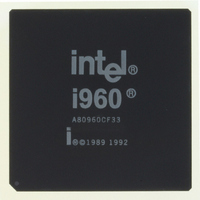A80960CF33 Intel, A80960CF33 Datasheet - Page 12

A80960CF33
Manufacturer Part Number
A80960CF33
Description
IC MPU I960CF 33MHZ 168-PGA
Manufacturer
Intel
Datasheet
1.A80960CF33.pdf
(70 pages)
Specifications of A80960CF33
Processor Type
i960
Features
CF suffix, 32-Bit with DMA, 4K Cache
Speed
33MHz
Voltage
5V
Mounting Type
Surface Mount
Package / Case
168-PGA
Family Name
80960
Device Core Size
32b
Frequency (max)
33MHz
Instruction Set Architecture
RISC
Supply Voltage 1 (typ)
5V
Operating Supply Voltage (max)
5.5V
Operating Supply Voltage (min)
4.5V
Operating Temp Range
0C to 100C
Operating Temperature Classification
Commercial
Mounting
Through Hole
Pin Count
168
Package Type
CPGA
Lead Free Status / RoHS Status
Lead free / RoHS Compliant
Other names
803084
Available stocks
Company
Part Number
Manufacturer
Quantity
Price
80960-40, -33, -25
12
Table 3.
80960CF Pin Description—External Bus Signals (Sheet 1 of 2)
READY
BTERM
BE3:0
Name
A31:2
D31:0
WAIT
ADS
W/R
Type
H(Z)
R(Z)
H(Z)
R(Z)
H(Z)
H(Z)
H(Z)
H(Z)
R(Z)
H(Z)
R(Z)
H(Z)
S(L)
R(1)
R(0)
R(1)
S(L)
S(L)
R(1)
I/O
O
S
O
S
O
S
O
S
O
S
I
I
ADDRESS BUS carries the physical address’ upper 30 bits. A31 is the most significant
bit; A2 is least significant. During a bus access, A31:2 identify all external addresses to
word (4-byte) boundaries. Byte enable signals indicate the selected byte in each word.
During burst accesses, A3:2 increment to indicate successive data cycles.
DATA BUS carries 32-, 16- or 8-bit data quantities depending on bus width
configuration. The least significant bit is carried on D0 and the most significant on D31.
When the bus is configured for 8-bit data, the lower 8 data lines, D7:0 are used. For 16-
bit data bus widths, D15:0 are used. For 32-bit bus widths the full data bus is used.
BYTE ENABLES select which of the four bytes addressed by A31:2 are active during
an access to a memory region configured for a 32-bit data-bus width. BE3 applies to
D31:24; BE2 applies to D23:16; BE1 applies to D15:8 BE0 applies to D7:0.
For accesses to a memory region configured for a 16-bit data-bus width, the processor
uses the BE3, BE1 and BE0 pins as BHE, A1 and BLE respectively.
For accesses to a memory region configured for an 8-bit data-bus width, the processor
uses the BE1 and BE0 pins as A1 and A0 respectively.
WRITE/READ is asserted for read requests and deasserted for write requests.
The W/R signal changes in the same clock cycle as ADS. It remains valid for the entire
access in non-pipelined regions. In pipelined regions, W/R is not ensured to be valid in
the last cycle of a read access.
ADDRESS STROBE indicates a valid address and the start of a new bus access. ADS
is asserted for the first clock of a bus access.
READY is an input which signals the termination of a data transfer. READY is used to
indicate that read data on the bus is valid or that a write-data transfer has completed.
The READY signal works in conjunction with the internally programmed wait-state
generator. When READY is enabled in a region, the pin is sampled after the
programmed number of wait-states has expired. When the READY pin is deasserted,
wait states continue to be inserted until READY becomes asserted. This is true for the
N
BURST TERMINATE is an input which breaks up a burst access and causes another
address cycle to occur. The BTERM signal works in conjunction with the internally
programmed wait-state generator. When READY and BTERM are enabled in a region,
the BTERM pin is sampled after the programmed number of wait states has expired.
When BTERM is asserted, a new ADS signal is generated and the access is completed.
The READY input is ignored when BTERM is asserted. BTERM must be externally
synchronized to satisfy BTERM setup and hold times.
WAIT indicates internal wait state generator status. WAIT is asserted when wait states
are being caused by the internal wait state generator and not by the READY or BTERM
inputs. WAIT may be used to derive a write-data strobe. WAIT may also be thought of
as a READY output that the processor provides when it is inserting wait states.
RAD
32-bit bus:
16-bit bus:
8-bit bus:
, N
RDD
BE3
BE2
BE1
BE0
BE3
BE2
BE1
BE0
BE3
BE2
BE1
BE0
, N
WAD
and N
WDD
wait states. The N
Byte Enable 3
Byte Enable 2
Byte Enable 1
Byte Enable 0
Byte High Enable (BHE)
Not used (driven high or low)
Address Bit 1 (A1)
Byte Low Enable (BLE)
Not used (driven high or low)
Not used (driven high or low)
Address Bit 1 (A1)
Address Bit 0 (A0)
Description
XDA
wait states cannot be extended.
enable D31:24
enable D23:16
enable D15:8
enable D7:0
enable D15:8
enable D7:0
Datasheet













